The haunting Australian mystery that still captivates 50 years on
Australian director Peter Weir and his collaborators take us behind the scenes of the iconic Picnic at Hanging Rock.
By Garry Maddox
August marks the 50th anniversary of one of the most famous Australian films of all time – an atmospheric mystery about three schoolgirls and a teacher from an elite women’s college who go missing on a day trip to Victoria’s Hanging Rock on Valentine’s Day, 1900.
Picnic at Hanging Rock, based on a 1967 novel by Joan Lindsay, launched the international career of the great director Peter Weir and remains a landmark for many of the cast and crew. And the restored version, released in Europe, the US and Australia this year, proves the film has lost none of its haunting power. The questions continue to linger long after the lights come up. Where did the missing girls and their teacher go? Why did the ethereal Miranda, played by Anne Lambert, know she would not be around for long? Did it really happen?
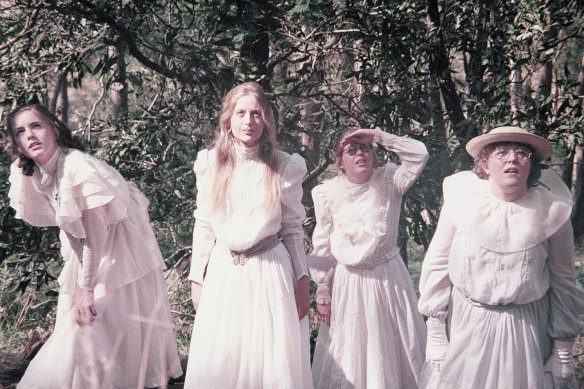
Picnic at Hanging Rock, starring (from left) Karen Robson as Irma, Anne Lambert as Miranda, Jane Vallis as Marion and Christine Schuler as Edith.Credit: B.E.F.
Weir, now 80, went on to direct masterful films including Gallipoli, Witness, Dead Poets Society and The Truman Show. To celebrate the anniversary, he and some of his collaborators reflect on making the film and its significance.
They reveal why the restored version is 12 minutes shorter than when Picnic became an international hit in 1975, how it went from filming in February to being released in August the same year – unimaginable now – and a new plan for a stage musical.
The genesis
In 1973, Gough Whitlam was prime minister, the Sydney Opera House was opened and there was what Weir calls “furious excitement in the air” as the emerging Australian film industry came alive. He was working on the screenplay of his first feature film, The Cars that Ate Paris, when TV presenter turned film producer Pat Lovell visited.
She handed him a book and said she wanted to film it. “I glanced down at the title, Picnic at Hanging Rock,” Weir says. “I read it in one long night and knew I had to do it.”
Lovell, who died in 2013, once said she thought Weir was the perfect director because his 1971 short feature Homesdale showed “he had a capacity for seeing the unusual and the sinister beneath typical, everyday events”.
“I read it in one long night and knew I had to do it.”
In the year before shooting Cars, Weir supervised work on the Picnic script. David Williamson was down to write it until a scheduling clash; Cliff Green took over. Weir thought the challenge with Picnic was to create a similar feeling to the novel. “It’s not literally taking the words to the screen,” he says. “As the director, it’s rather like putting music to a libretto for an opera. So I had to compose with images – the kind of music that I’ll make – that becomes the film.”
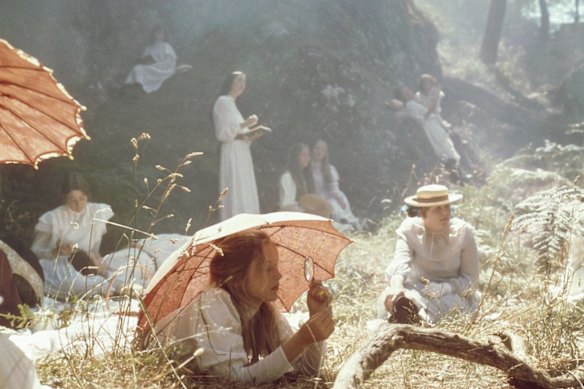
Peter Weir’s Picnic at Hanging Rock brings Joan Lindsay’s story of mysterious disappearances to life.
The other issue was the unresolved mystery about the disappearance. “This was at the same time its great originality and its greatest danger,” Weir says. “The audience expected a solution. How to divert interest away from that expectation? Fortunately, I had two years to think about it.”
The day after Lovell and Weir optioned the film rights, they visited Hanging Rock, about 80 kilometres north-west of Melbourne. Weir says he felt “a power in that pile of stone”, adding “one of my first impressions was what looked like faces carved into the living rock, like those monoliths on Easter Island – a trick of the light I thought I could use. Revisiting years later, a ranger told me tourists often take home bits of rock as a souvenir. Curiously many later mailed them back, saying they got “a bad feeling” from their chunk of Hanging Rock.”
Casting the film
With Cars producers Hal and Jim McElroy on board, Weir auditioned teenage girls, but found it was trickier than expected. “In Sydney and Melbourne, they seemed too sophisticated, except for Anne Lambert,” he says. He says he found girls who seemed more suited to the 19th century in Adelaide. “They seemed to be from another era – a simpler time,” Weir says. “[So] that’s where most of the cast came from.”
“What’s extraordinary is that it still has such a life force – how it still speaks to people.”
Lambert, who was 19, was working on TV series The Class of ’74 at the time. “I was probably one of the oldest,” she says. “Karen Robson [who played Irma] was 17.”
The look
Weir worked closely with cinematographer Russell Boyd, who was inspired by Australian painters of the 19th century including Tom Roberts, to capture the particular Australian light that makes the film so distinctive. Another inspiration for Weir was early colour photography by France’s Jacques Henri Lartigue.
“Russ went off and had to work out ways he would produce this kind of special atmosphere,” he says. “It ended up with Russ in the wedding department of David Jones, buying bits of veil to try to find different ways of netting the camera”. Diffusing the light created the atmospheric look they wanted.
The shoot
Lambert thought at the time that they were making something special because the film “was so different to not only what I’d done but what was around generally at the time”. Her many fond memories of the shoot included meeting Lindsay, then 78, after a scene on the rock that left her doubting her performance.
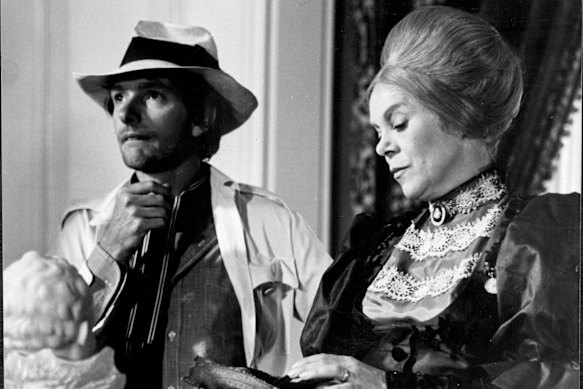
Director Peter Weir and Rachel Roberts making Picnic at Hanging Rock.
It was an odd meeting. “She just threw her arms around me and held me, spoke into my ear and said ‘oh Miranda, it’s been so long’,” Lambert says. “She was obviously very moved.
“When we came apart, I could see she had tears in her eyes. I wasn’t quite sure what was happening but I somehow found it incredibly validating. Any doubt about myself felt like it was just washed away.”
Camera operator John Seale, who went on to join Boyd as an Australian cinematography great, remembers Hanging Rock as an eerie place to shoot. “The wind works its way through those rocks, which Peter put into sound and the music was hinting at … as though the rocks were talking to you,” he says. “That’s what he got magically into the film: that the girls were carried away into a different sphere.”
Seale loved seeing Weir and Boyd work together. “Watching them put the visuals together for the film was a real privilege,” he says. “I remember thinking, ‘Oh gee, I’m working with some of the greats’.”
Mind you, Seale adds that he joked with Weir recently that they didn’t really know what they were doing in those early years of the Australian film renaissance. “Peter laughed and said, ‘We didn’t. We just made them’,” he says.
Jacki Weaver, who played school staff member Minnie, describes shooting the film as a “magical time”. She realised Weir was a visionary director. “Look at his catalogue of films – they’re amazing and all so different from each other, as well as from most films,” she says.
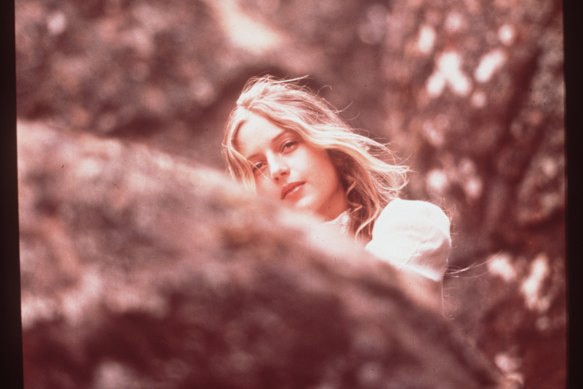
Anne Lambert as Miranda, who disappears into Hanging Rock.
Despite her doubts, Weir appreciated Lambert’s performance as he edited Picnic. “She disappears with the other girls quite early in the story and I found on a first cut I missed her and decided to ‘bring her back’, at least in a dreamy way, to keep her presence deeper into the film,” he says.
The screening
So how did it get to cinemas so fast? “The two years before I began the film proved invaluable – a lot of time to think the thing through, a lot of problems worked out,” Weir says. “That preparation showed in the first cut of the picture – it was there. That was why we could keep to a tight delivery schedule.”
Weir remembers that it was exciting but tense showing Picnic to an audience for the first time and wondering whether it was working. Positive reviews and strong box office in Australia – joining Alvin Purple as the country’s biggest hits – and later Europe indicated it was.
But it was four years before it was released in the US. “They seemed unsure how to market it,” Weir says.
Enduring success
In her enigmatic way, Lindsay was the first person close to the film who thought it would have a special life. “She said ‘this film is going to be highly significant for some of you’,” Weir says.
As beautifully as the film is made and as compelling the story is, Lambert says its success owed something to the times. “There was something about the way Picnic was received that was a celebration of us finding out cultural identity, finding our voice, being able to tell our own stories,” she says. “What’s extraordinary is that it still has such a life force – how it still speaks to people.”
Watching the restored version before a Q&A with a German audience, she found herself transported. “That indefinable thing it has – that atmosphere – is extraordinary,” Lambert says. “You see different things every time you see it. This time it was all about Sara [played by Margaret Nelson]. I was really so moved by that storyline and her performance.”
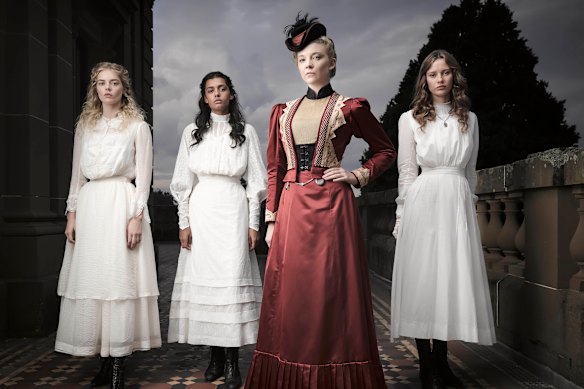
(From left) Samara Weaving, Madeleine Madden, Natalie Dormer and Lily Sullivan in the Picnic at Hanging Rock TV series.
After the film inspired a TV series (starring Natalie Dormer, Lily Sullivan and Samara Weaving) and this year a Sydney Theatre Company play, Weaver says there are now plans for a musical. “I got an email asking if I’d talk about the experience of making it,” she says.
A true story?
One enduring myth about the film is that it’s based on a true story. Lindsay was ambiguous in her introduction to the novel, writing that since “all the characters who appear in this book are long since dead, it hardly seems important” whether it is fact or fiction.
Weir thinks it was “either a metaphor or something personal” for Lindsay. “What’s true for me is the disappearance,” he says. “For a person to disappear, it’s the most terrible thing because for those left behind they’re neither dead nor alive. There’s no closure.”
The distributors played off the ambiguity. Weaver says that doing publicity “we were discouraged from saying that it was a piece of fiction”.
But there is no doubt it’s an invented story. When Lindsay submitted the novel for publication, then-junior editor Sandra Forbes suggested it would have more impact by deleting a final chapter that suggested the disappearance involved a type of time warp. Lindsay agreed, which left the ending a mystery until the final chapter was published after her death in 1984.
The director’s cut
While many director’s cuts are longer, Weir made Picnic shorter when, sitting with an audience, he realised the middle needed tightening because the tension was dissipating. He went to Lovell and the financiers and said he wanted to cut 12 minutes before the European release.
“They thought I was making a joke – ‘You want to cut a hit film?’ they said. I said, ‘Yes, it will only be better’. They didn’t agree.”
It was not until Picnic was released on video in the 1990s that Weir cut the 12 minutes. As well as trimming scenes that were too long by 10 or 15 seconds, he lost two whole scenes after the disappearance. “They were quite nice scenes but, for me, it was losing the eeriness, where you dipped into the wrong kind of slowness,” he says.
So why was Australian film so vibrant that Picnic was shut out at the 1976 AFI Awards by The Devil’s Playground and Caddie? “We worked in complete freedom in the 1970s and were stimulated by the great films being made around the world and shown at our festivals,” Weir says. “That was our film school.”
Coming soon: Must-see movies, interviews and all the latest from the world of film delivered to your inbox. Sign up for our Screening Room newsletter.